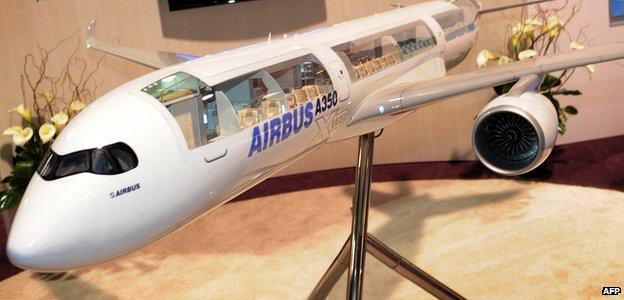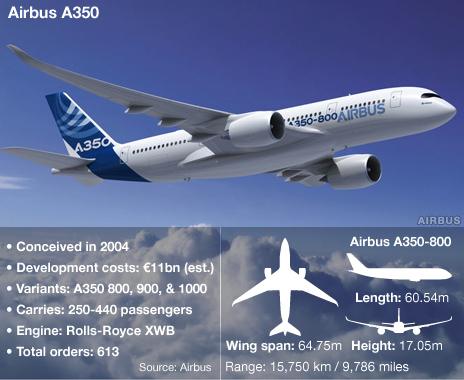Airbus conquers the final frontier with Japan deal
- Published

Airbus's newest plane A350 has helped it crack the Japanese market previously dominated by rival Boeing
To those who follow the airline industry closely, Airbus's announcement of a deal with Japan Airlines (JAL) may still seem a bit surreal.
Come to think of it, Airbus did not even want to build the A350 plane in the first place. It was Boeing's plans to build the Dreamliner that prompted the Toulouse-based firm to alter its course.
And now, years later, it is the same plane that has helped it knock down Boeing's near monopoly of the Japanese market.
Airbus has agreed to sell 31 of its A350 planes, in a deal worth nearly $9.5bn (£5.9bn) at list prices.
"This is a big win for Airbus," says Chris de Lavigne, an aviation analyst with consulting firm Frost and Sullivan.
"This was the final frontier for them and they have conquered it."
'Some frustration'
The A350 is Airbus's newest plane and a direct competitor to US rival Boeing's 787 Dreamliner.
The Dreamliner programme has been hurt by a spate of safety and technical issues in recent months.
Earlier this year, a fire broke out in one of JAL's 787 Dreamliners. Then an All Nippon Airways (ANA) flight had to make an emergency landing because of a battery fault and a fire in one of the electrical compartments.
The incidents resulted in the entire 787 fleet being grounded in January and JAL and ANA having to cancel flights
The fleet has since been put back in the air, but in August ANA reported that it had found a wiring defect in a fire extinguisher system on three of its 787 Dreamliner jets.
Analysts say the issues have played a role in helping Airbus break into the Japanese market.
"I think there was some frustration with the 787 programme," says Timothy Ross, head of transport research for Asia, at Credit Suisse.
"It did provide a window for Airbus to make a case for its planes in the Japanese market."
First mover advantage?
Some industry watchers suggest that Airbus also benefited from introducing the A350 ahead of Boeing's 777X - the latest version of its highly successful 777 series - and also a competitor to the A350.
Airbus already has more than 750 orders for the A350 and hopes to start delivering the first planes to customers by the end of 2014.
JAL is scheduled to receive its A350s by 2019. This means the aircraft would have already been in service for nearly four years by the time JAL receives its planes, giving enough time to sort out any potential teething issues.
If it opted for Boeing's 777X - the deliveries of which are not expected to begin for some time - the carrier would most likely have been among the first to operate the planes.
Analysts say the problems JAL faced as one of the first operators of the 787 Dreamliner may have played a role in its decision to chose the A350 planes.
The 787 issues "inevitably led to doubts about execution, resources and time," says Richard Aboulafia, an airline analyst with the Teal Group.
He adds that Boeing has suffered as a result of not staying ahead of the competition.
"It's the price to be paid for passivity, by not launching this plane one year ago," he explains, referring to the 777X.

'True competition'
Boeing has dominated the Japanese market for the past many decades. According to Frost and Sullivan, the US plane-maker has an 80% share of the country's jet market.
Not only have Japanese carriers preferred to buy Boeing planes, Japanese manufacturers have also been key supplier of parts to the US firm.
The close political ties between the two countries, which often play a key role in securing large plane deals, have also helped Boeing maintain its dominance.
But analysts say that given the strong hold enjoyed by Boeing in Japan, it was just a matter of time before Airbus managed to break into it.
"It is just natural progression, the market is now opening up," says Mr Lavigne of Frost and Sullivan.
"It was going to happen at some point of time. You can't have a monopoly market forever."
He adds that the JAL deal may see further opportunities open up for Airbus in the world's third-largest economy.
"This could now open the whole Japanese market for Airbus," he says. "There is now going to be true competition between the two players."
Advantage Japan?
That can only be good news for Japanese carriers.
As the two plane-makers vie for a share of the market, they are are likely to offer much sweeter and more competitive deals to secure orders than they would in a monopoly market.
"As an airline you want to be able to maintain a competitive tension between two of the biggest airplane manufacturers in the world," says Mr Ross, of Credit Suisse.
"That helps not just with better purchase prices, but also with after-sales support and maintenance guarantees."
Japan's largest airline, ANA, is looking to place an order for 25 jets and is expected to take a decision in the coming months.
The firm's fleet is currently dominated by Boeing planes. So far it has given no indication of which plane-maker it may go with.
Maybe, it's just waiting for those sweeteners.